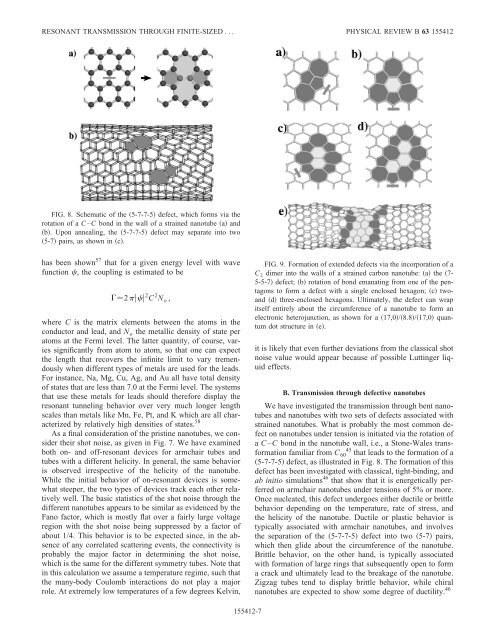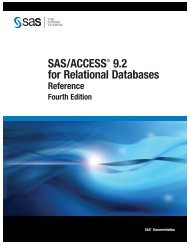using standard prb s - The Department of Physics and Astronomy
using standard prb s - The Department of Physics and Astronomy
using standard prb s - The Department of Physics and Astronomy
You also want an ePaper? Increase the reach of your titles
YUMPU automatically turns print PDFs into web optimized ePapers that Google loves.
RESONANT TRANSMISSION THROUGH FINITE-SIZED . . . PHYSICAL REVIEW B 63 155412FIG. 8. Schematic <strong>of</strong> the 5-7-7-5 defect, which forms via therotation <strong>of</strong> a C –C bond in the wall <strong>of</strong> a strained nanotube a <strong>and</strong>b. Upon annealing, the 5-7-7-5 defect may separate into two5-7 pairs, as shown in c.has been shown 57 that for a given energy level with wavefunction , the coupling is estimated to be2 2 C 2 N o ,where C is the matrix elements between the atoms in theconductor <strong>and</strong> lead, <strong>and</strong> N o the metallic density <strong>of</strong> state peratoms at the Fermi level. <strong>The</strong> latter quantity, <strong>of</strong> course, variessignificantly from atom to atom, so that one can expectthe length that recovers the infinite limit to vary tremendouslywhen different types <strong>of</strong> metals are used for the leads.For instance, Na, Mg, Cu, Ag, <strong>and</strong> Au all have total density<strong>of</strong> states that are less than 7.0 at the Fermi level. <strong>The</strong> systemsthat use these metals for leads should therefore display theresonant tunneling behavior over very much longer lengthscales than metals like Mn, Fe, Pt, <strong>and</strong> K which are all characterizedby relatively high densities <strong>of</strong> states. 58As a final consideration <strong>of</strong> the pristine nanotubes, we considertheir shot noise, as given in Fig. 7. We have examinedboth on- <strong>and</strong> <strong>of</strong>f-resonant devices for armchair tubes <strong>and</strong>tubes with a different helicity. In general, the same behavioris observed irrespective <strong>of</strong> the helicity <strong>of</strong> the nanotube.While the initial behavior <strong>of</strong> on-resonant devices is somewhatsteeper, the two types <strong>of</strong> devices track each other relativelywell. <strong>The</strong> basic statistics <strong>of</strong> the shot noise through thedifferent nanotubes appears to be similar as evidenced by theFano factor, which is mostly flat over a fairly large voltageregion with the shot noise being suppressed by a factor <strong>of</strong>about 1/4. This behavior is to be expected since, in the absence<strong>of</strong> any correlated scattering events, the connectivity isprobably the major factor in determining the shot noise,which is the same for the different symmetry tubes. Note thatin this calculation we assume a temperature regime, such thatthe many-body Coulomb interactions do not play a majorrole. At extremely low temperatures <strong>of</strong> a few degrees Kelvin,FIG. 9. Formation <strong>of</strong> extended defects via the incorporation <strong>of</strong> aC 2 dimer into the walls <strong>of</strong> a strained carbon nanotube: a the 7-5-5-7 defect; b rotation <strong>of</strong> bond emanating from one <strong>of</strong> the pentagonsto form a defect with a single enclosed hexagon; c two<strong>and</strong>d three-enclosed hexagons. Ultimately, the defect can wrapitself entirely about the circumference <strong>of</strong> a nanotube to form anelectronic heterojunction, as shown for a 17,0/8.8/17,0 quantumdot structure in e.it is likely that even further deviations from the classical shotnoise value would appear because <strong>of</strong> possible Luttinger liquideffects.B. Transmission through defective nanotubesWe have investigated the transmission through bent nanotubes<strong>and</strong> nanotubes with two sets <strong>of</strong> defects associated withstrained nanotubes. What is probably the most common defecton nanotubes under tension is initiated via the rotation <strong>of</strong>a C –C bond in the nanotube wall, i.e., a Stone-Wales transformationfamiliar from C 45 60 that leads to the formation <strong>of</strong> a5-7-7-5 defect, as illustrated in Fig. 8. <strong>The</strong> formation <strong>of</strong> thisdefect has been investigated with classical, tight-binding, <strong>and</strong>ab initio simulations 46 that show that it is energetically perferredon armchair nanotubes under tensions <strong>of</strong> 5% or more.Once nucleated, this defect undergoes either ductile or brittlebehavior depending on the temperature, rate <strong>of</strong> stress, <strong>and</strong>the helicity <strong>of</strong> the nanotube. Ductile or plastic behavior istypically associated with armchair nanotubes, <strong>and</strong> involvesthe separation <strong>of</strong> the 5-7-7-5 defect into two 5-7 pairs,which then glide about the circumference <strong>of</strong> the nanotube.Brittle behavior, on the other h<strong>and</strong>, is typically associatedwith formation <strong>of</strong> large rings that subsequently open to forma crack <strong>and</strong> ultimately lead to the breakage <strong>of</strong> the nanotube.Zigzag tubes tend to display brittle behavior, while chiralnanotubes are expected to show some degree <strong>of</strong> ductility. 46155412-7
















